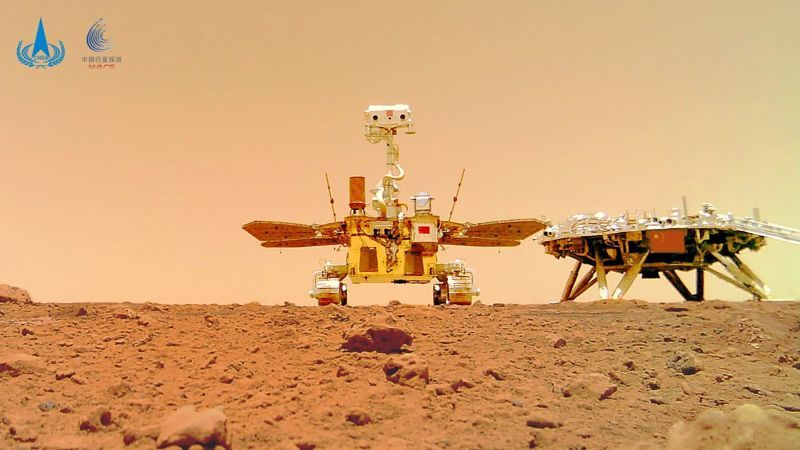China's Mars rover dormant likely due to dust
Sign up for CNN’s Wonder Theory science newsletter. Explore the universe with news on fascinating discoveries, scientific advancements and more.
CNN —
China’s Zhurong rover on Mars has been in hibernation since last May due to an “unpredictable accumulation” of dust, mission designer Zhang Rongqiao said, Chinese state broadcaster CCTV reported on Tuesday.
Powered by solar energy, Zhurong landed in a large plain in Mars’ northern hemisphere called Utopia Planitia on May 15, 2021, and went into hibernation last May during winter.
“According to our analysis, the biggest possibility is that because of unpredictable accumulation of Martian dust, its power generation capacity was reduced and it was too low to wake itself up,” Rongqiao said, explaining why the rover has since been dormant.
This image showing the rover and the lander on the surface of Mars was taken by a separable camera deployed by the Zhurong rover in 2021. CNSA
He said the rover is expected to automatically wake up when the light and weather conditions improve with temperatures inside the cabin surpassing -15 degrees Celsius (5 degrees Fahrenheit) and when there is enough sunlight to charge the battery to at least 140 watts.
While he acknowledged there is a possibility the rover may never exit hibernation if dust accumulation exceeds 40%, he stressed the rover’s dormancy is “within our expectation.”
The rover’s primary mission, which lasted for three months, was to search for signs of ancient life. It investigated the minerals, environment and distribution of water and ice in the plain, which is all part of the largest impact basin in the Martian northern lowlands.
The data collected by the rover has found evidence suggesting water persisted on Mars for much longer than expected, findings that were published last year in a study in the journal Science Advances.
Rongqiao said the rover was designed to have a working duration of 90 days on Mars, but has so far worked 358 days and traveled 1,921 meters (6,302 feet) on Mars.
Martian winters can be tough on any spacecraft exploring the red planet, when more dust becomes lofted in the air, which obscures sunlight from reaching solar panels, and the planet’s already frigid temperatures drop even lower. NASA’s Ingenuity helicopter experienced issues during the same Martian winter that caused Zhurong to go into hibernation, although the chopper weathered the season and just completed its 50th flight on Mars.
Rovers and landers are no strangers to the risks that the Martian environment poses. The NASA InSight lander’s mission came to an end in December after spending nearly 1,500 days on Mars. Mission managers declared the program’s end after the lander failed to respond to two messages from mission control at NASA’s Jet Propulsion Laboratory in Pasadena, California.
The mission ended more than four years after it first landed on November 26, 2018, revealing new information about the interior of Mars. Designed to last for only two years, InSight’s mission was extended twice. But a heavy accumulation of dust on its solar panels caused a steady drop in the lander’s power source.
Source: CNN


